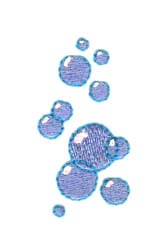Water Embroidery
Water embroidery is a beautiful art form that can elevate any piece of fabric to a whole new level of elegance and beauty. Embroidery has been a part of human culture for centuries, and water embroidery is one of the most unique and fascinating forms of embroidery there is.
If you've ever struggled to find the perfect embellishment for your fabric project, or you're tired of the same old embroidery designs, then water embroidery might be just what you need. With its delicate textures, vibrant colors, and intricate patterns, water embroidery can turn even the most mundane piece of fabric into a work of art.
The target of water embroidery is to create a design that appears as though it is floating on the surface of the fabric. This is achieved by using a water-soluble stabilizer, which dissolves in water after the embroidery is complete. This technique allows for more intricate designs and greater detail, and also makes the embroidery look more natural and organic.
Water embroidery requires a certain level of skill and patience, but once you get the hang of it, it can be a rewarding and enjoyable hobby. The key is to start with simple designs and work your way up to more complex ones. You can experiment with different colors, textures, and patterns to create a unique and personalized look that reflects your own style and personality.
Water Embroidery Techniques and Tips
If you're interested in trying your hand at water embroidery, here are a few tips to help you get started:

Choosing the Right Fabric
The type of fabric you choose for your water embroidery will have a big impact on the final result. Lightweight fabrics, such as organza, tulle, and batiste, work best because they allow the embroidery to float on the surface of the fabric. Avoid heavier fabrics, such as denim or corduroy, as they will not produce the same effect.

Choosing the Right Thread
The type of thread you use for your water embroidery should be lightweight and delicate, such as silk or rayon embroidery thread. Avoid using heavy or thick threads, as they will weigh down the embroidery and make it less effective. You can experiment with different colors and textures to create unique and eye-catching designs.
The Process of Water Embroidery
The process of water embroidery begins by transferring the design onto the water-soluble stabilizer using a water-soluble pen or pencil. Next, the stabilizer is placed on top of the fabric, and the embroidery is stitched onto the stabilizer. Once the embroidery is complete, the stabilizer is dissolved in water, leaving behind the embroidered design.

Tips for Success in Water Embroidery
Here are a few additional tips to help you achieve success with your water embroidery:
- Use a high-quality digitized embroidery design for the best results.
- Use a water-soluble stabilizer that is appropriate for your fabric and thread choice.
- Don't rush the embroidery process - take your time and work slowly and carefully.
- Experiment with different colors, textures, and patterns to create unique and interesting designs.
- Be patient when dissolving the stabilizer - rushing or using too much water can damage the embroidery.
Question and Answer
What is water embroidery?
Water embroidery is an embroidery technique that uses water-soluble stabilizer to create embroidered designs that appear to be floating on the surface of the fabric.
What types of fabric are best suited for water embroidery?
Lightweight fabrics such as organza, tulle, and batiste work best for water embroidery.
What kind of thread should I use for water embroidery?
Lightweight and delicate threads, such as silk or rayon embroidery thread, are best for water embroidery.
Can I use water embroidery to decorate clothing?
Yes! Water embroidery can be used to decorate clothing, as well as accessories, home decor items, and more.
Conclusion of Water Embroidery
Overall, water embroidery is a unique and beautiful form of embroidery that can add a touch of elegance and charm to any fabric project. By following the tips and techniques outlined in this article, you can create your own stunning water embroidery designs and take your embroidery skills to the next level.
Gallery
Quilters Cottage Norfolk: Water Soluble Embroidery

Photo Credit by: bing.com / water embroidery soluble quilters norfolk cottage
Water, Embroidery With Beading, Debbievandyke.com | Mar

Photo Credit by: bing.com / water embroidery textile beading beaded
Water Bubbles Embroidery Designs, Machine Embroidery Designs At

Photo Credit by: bing.com / embroidery bubbles water patterns designs embroiderydesigns pinnacle machine
Quilters Cottage Norfolk: Water Soluble Embroidery

Photo Credit by: bing.com / embroidery water soluble quilters norfolk cottage
A Lively Hope: Waves Of Water Embroidery Pattern

Photo Credit by: bing.com / embroidery water pattern waves alivelyhope


0 Response to "Water Embroidery"
Post a Comment